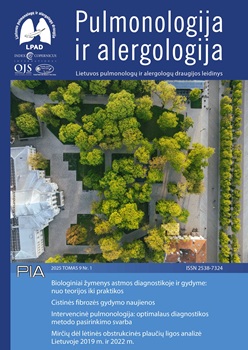COMPARISON OF IMPULSE OSCILLOMETRY INDICES AND FEV1 DURING METHACHOLINE CHALLENGE AND BRONCHODILATOR TESTS
Abstract
Spirometry is the standard method for assessing bronchial responsiveness in the methacholine challenge test (MCT) and bronchodilation test (BDT), but impulse oscillometry (IOS) may serve as an alternative. Aim of the study. To evaluate whether IOS can substitute spirometry in MCT and BDT. Methods. The study included 20 subjects with suspected asthma (12 males, 8 females, mean age 41.5 ± 15.1). All participants underwent MCT using dosimeter (Provo.X, Ganshorn, Germany). FEV1 (SpiroScout, Ganshorn, Germany) and IOS (Tremoflo C-100, Thorasys, Canada) parameters – airway resistance at 5 Hz (R5), 20 Hz (R20), 5–20 Hz (R5–20), reactance at 5 Hz (X5), reactance area at 5 Hz (AX5) were recorded at the beginning of the test and after each methacholine dose. In subjects for whom MCT was positive, bronchodilation using 400 µg of salbutamol was performed and after 15 min FEV1 and IOS indices were re-recorded. Results. At baseline and after the last methacholine dose a significant correlation was observed between FEV1 and all IOS indices (p < 0.05), except R5–20 at baseline. ΔMCTFEV1 (difference between baseline and after the last methacholine dose) significantly correlated with ΔMCTR5, ΔMCTX5 and ΔMCTAX5 in all subjects (p < 0.05). Six subjects (30%) had a positive MCT for whom ΔBDTFEV1 (difference between the value before and after BDT) significantly correlated with ΔBDTX5 and ΔBDTR5–20 (p < 0.05). Conclusion. IOS may be an alternative to spirometry in MCT and BDT. The most informative IOS parameters for MCT were R5, X5, and AX5; for BDT – X5 and R5–20.


